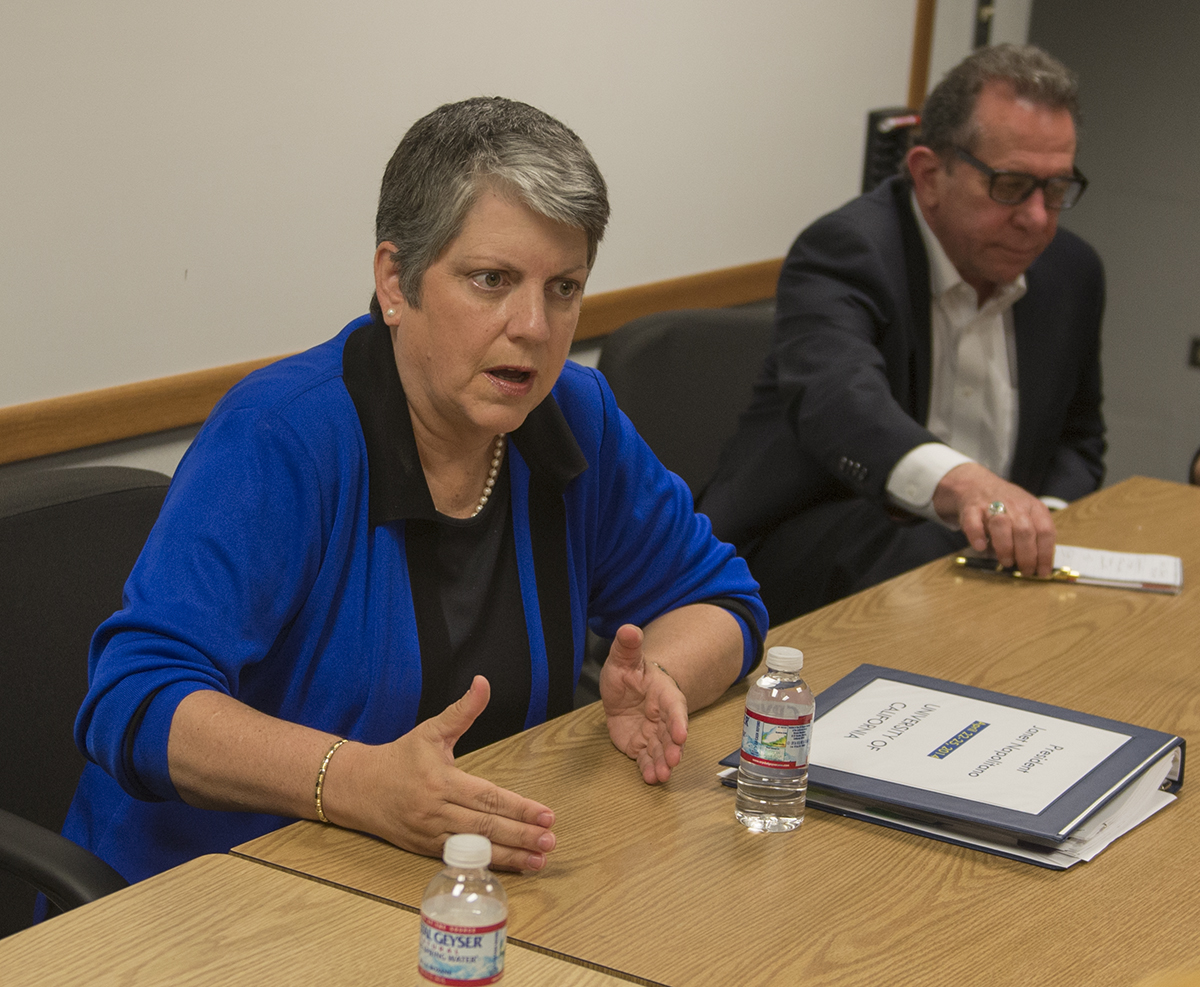Submission: Race-blind admissions single out important criterion for exclusion

University of California President Janet Napolitano discussed diversity in higher education during her interview with the Daily Bruin’s editorial board on Friday. During the interview, Napolitano spoke about last week’s Supreme Court decision on affirmative action in Michigan.
(Brandon Choe/Daily Bruin senior staff)
By Special To The Daily Bruin
April 29, 2014 12:03 a.m.
BY JANET NAPOLITANO
What if the Supreme Court had ruled this past week that states have the constitutional right to require that their public universities consider only SAT scores when making admissions decisions?
Never would happen, you might say. Because it’s absurd. Common sense dictates that universities should consider many factors about a student when deciding whom to admit. People are complex and diverse. We’re of different genders, from different backgrounds, with different talents and academic interests. We are a wonderful, maddening mix.
Differences in perspectives matter. We want our students to learn in a community that reflects academic strengths and the diversity – gender, class, religion, national origin, and, indeed, race and ethnicity – that characterize our communities.
Consequently, admission is not a mathematical exercise performed by a robot. Florida, Michigan, Washington state and my own state of California, however, have taken race, ethnicity, gender and other attributes that define a person out of the admissions process. As president of the 10-campus University of California system, the nation’s largest public research institution, I know firsthand the practical consequences of laws, such as the 2006 Michigan initiative the Supreme Court upheld this past week, that ban the consideration of such attributes in admissions. Although last Tuesday’s technically narrow decision doesn’t forbid race-conscious admissions at public universities, it opens the door for more states to follow Michigan and California’s lead.
Race, ethnicity, gender or any other cultural or biological trait should never be the sole criterion for admission to any public university – this, too, would be absurd. By the same measure, they should not be singled out for exclusion. Race, for example, still shapes how people experience and react to the world.
In California, the legal barrier is Proposition 209, a state initiative passed in 1996. California is the most diverse state in the nation, and, like other academic institutions, the UC has learned that diversity is important to our success. Diversity in classrooms and research labs improves learning for all students. It helps create an environment that transcends each student’s experiences, assumptions and stereotypes. It teaches students how to function in a community that reflects the diversity they will find once they graduate. It fosters a campus climate where underrepresented minorities feel safe and respected.
In short, diverse campuses turn out graduates who are better prepared to succeed in modern workplaces and in our increasingly interconnected world. Diversity also gives the public confidence that the doors of the university – and the paths to leadership and economic well-being that the university provides – are open to everyone.
As Justice Sonia Sotomayor explained while referencing the UC’s amicus brief, Proposition 209 produced “an immediate and precipitous decline in the rates at which underrepresented minority students applied to, were admitted to, and enrolled” at the University. At the UC’s most selective campuses, for example, admission and enrollment rates for underrepresented minorities dropped by more than half immediately after the ban was put in place.
In the nearly two decades since Proposition 209 was passed, we have worked hard to achieve campus diversity in a race-blind fashion – and we’ve spent more than half a billion dollars on programs and policies to do so. We have partnered with under-resourced high schools to help students prepare for college. We have guaranteed admission to the top students at all public and private high schools. We have lessened our reliance on standardized tests and shifted toward a more holistic, and time-consuming, review of applications. And we have spent hundreds of millions of dollars on financial aid, expanding the pipeline of applicants from underrepresented minority groups – all without targeting race.
These are initiatives that make good sense regardless of whether a university is allowed to consider race in admissions. And we have had some success. Because of our expanded outreach efforts, the UC is the national leader among highly selective institutions in enrolling low-income students and those who will be the first in their families to graduate from college. For the first time, Latinos – the largest ethnic group among California high school graduates – have surpassed white students in admission to the 2014 freshman class.
Despite our best efforts, the UC still struggles to build an undergraduate student body that fully reflects the diversity of the state. Across the university, the percentages of African Americans and Native Americans enrolled in 2012 remained lower than the corresponding percentages in 1995. The percentage of Latino students has increased, but not enough to keep pace with the explosive growth of Latino high school graduates.
The problem is most severe in our graduate schools, which educate the professionals who will serve California’s increasingly diverse population in the decades to come. At times, the entering classes at some of our medical schools have not had a single African American student, despite significant outreach efforts. The proportion of underrepresented minorities in the university’s business schools is less than half the national average for comparable institutions.
Our experience in California gives Michigan – and other states that may be considering bans on race-conscious admissions – a sense of what lies ahead. For nearly two decades, we have served as a laboratory of innovation for race-blind strategies to promote diversity on our campuses. We will continue these vital efforts. But as long as the University is prohibited from considering all of an applicant’s characteristics, we will be doing so with one arm tied tightly behind our backs.
Napolitano is the president of the University of California. This submission originally appeared in the Washington Post on April 25. It has been reprinted here with permission.


